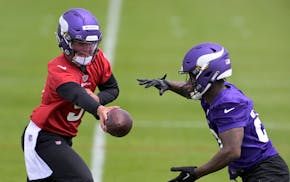Forty-one years ago, following a brutal winter that pummeled Minnesota's pheasant population, the state canceled the pheasant hunting season.
The radical step was encouraged by hunters, sportsmen's groups and others who believed that closing the season would help the pheasant population recover. Common sense told them that if they didn't kill ringnecks that fall, there would be more birds the following year.
They were wrong -- dead wrong.
As Department of Natural Resources wildlife biologists argued at the time, closing the season didn't affect the pheasant population at all because of the nature of pheasants and the limitations placed on hunters. Hunters then and now are allowed to shoot only roosters (males).
"And pheasants are polygamous," said Kurt Haroldson, DNR pheasant biologist. One rooster fertilizes many hens. So the hundreds of thousands of roosters killed by hunters each year are essentially "surplus" birds. Only a small percentage of males are needed for reproduction.
And hunters never kill all the roosters in an area, Haroldson said, meaning some are always there to mate with hens the following spring.
"The law of diminishing returns really influences how many roosters are taken," he said. "You will get to some point, when the population is low enough, that it's just too hard to take additional birds, and hunters give up." That's why the number of pheasant hunters in the field declines as the season goes on.
The other limiting factor is habitat -- it can support only so many birds. Close the hunting season one year or five years, and you won't appreciably affect the pheasant population. Natural predation, habitat restrictions and weather will continue to take a toll on pheasants, limiting the population, whether they are hunted or not.
"Basically, you can't stockpile pheasants," Haroldson said.
Al Berner, a retired DNR pheasant biologist, started at the agency in 1969. He said he and others in the agency's Wildlife Division, including its leaders, argued to no avail against closing the pheasant season that year.
"We couldn't convince the people that hunting was not a factor," he said. But hens, habitat and weather control the pheasant population, Berner said.
So where's the proof? The 1969 season closure provided it.
Berner and other biologists compared the pheasant populations in the northern two tiers of counties in Iowa -- where a 54-day, three-bird limit was held that year -- with the southern two tiers of Minnesota counties, where the season was closed. Both areas had been devastated by one of the most severe winters to hit in 30 years. But the next spring, both states showed an almost identical percentage increase in pheasants.
"We believe there is no biological reason liberal cocks-only pheasant hunting seasons cannot be maintained ... even at very low population levels," Berner's study concluded.
But the concept died hard. In 1970, Minnesota offered a 16-day pheasant hunting season but left closed a large swath in western and southwestern Minnesota. And because of concerns over low pheasant numbers, the Viking Sportsmen's Club in Alexandria persuaded the DNR to close pheasant hunting in Douglas County from 1973 to 1975. About 5,000 pen-raised pheasants were stocked yearly to try to boost pheasant numbers. Meanwhile, the other 13 counties in the west-central region were open for pheasant hunting during those three years.
In the end, the population trend in all of the counties was similar.
"The locals eventually got the idea that everyone else around them was hunting and getting birds and they were doing all this and nothing was happening," Berner said.
Haroldson believes the lessons from that era were a turning point for the DNR, giving it ammunition to base wildlife decisions on science instead of politics or public impressions.
"Before then, we fiddled with the season length every year," he said. "This gave them enough information to stand up to political pressure."
And whatever happens to the pheasant population now, it's unlikely hunters will ever see a season closed again.
Doug Smith • dsmith@startribune.com
Jayson Tatum scores 25 to lead Celtics past Cavaliers 113-98 and into 3rd consecutive East finals

Vikings fans could get early look at McCarthy

Slump by Twins' Kirilloff raises questions about his health
St. Thomas hockey to follow Arizona State into NCHC, as league expands to 10 teams

